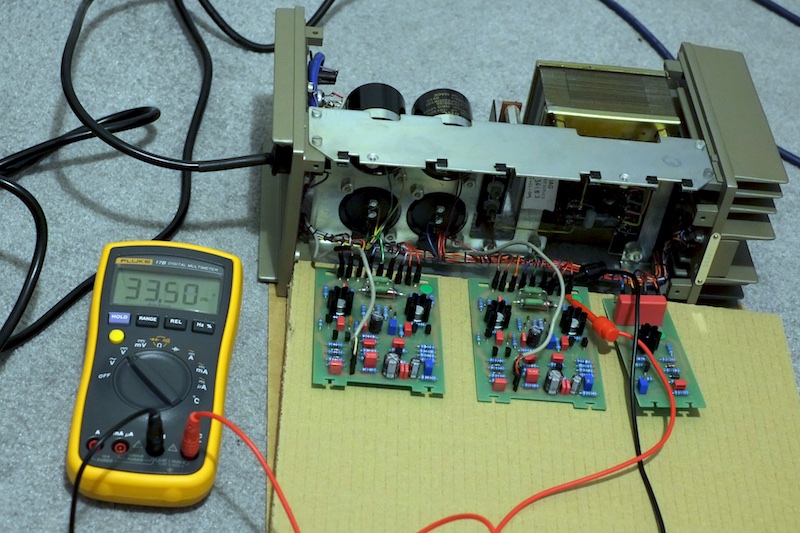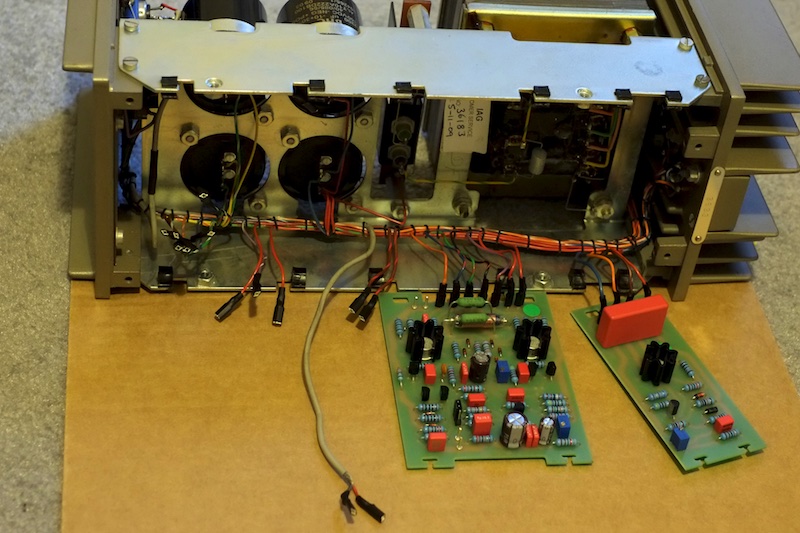A weeks or two ago I took the plunge and ordered a set of
Dada Electronics High-End Upgrade boards for my trusty 303. I really like this amp and can't imagine ever not running it in a system somewhere, so it kind of makes sense to take it as far as I can without altering the inherent Quad 303-ness that I like so much about it, plus hopefully extend it's life and make it more easily serviceable.
The Dada boards are beautifully made; modern glass-fiber PCBs, high quality components, nice multi-turn trim-pots etc, far nicer than the original 1960s brown boards that tend to fall apart if one tries to de/re-solder any components, even Quad's own service centre managed to lift some tracks when my amp was last serviced. These boards are entirely to the Quad 303 design, not a modification, so technically it's still a 303.
Fitting them involves desoldering the old boards, soldering nice clip-tags to the Quad wiring loom and heat-shrinking it all nice and neat. The boards then just plug in and are ready for setup.

The voltage levels need setting: 67v between pin 1 & 9, 33.5v between pin 1 & 5 and finally around 10mv between pin 4 & 6. Unfortunately there was an issue with one driver board (I could get no reading for bias), so I had to wait for another one to be shipped out by Dada. It landed today. One thing well worth noting for folk planning to do this update with a 1960s MkI Quad 303 like mine is that Quad flipped the driver-board input lead (the grey lead running to the front of the boards) in the later board design which the Dada boards copy, so despite my having photographs to work from I managed to get the signal and ground reversed resulting in an absolutely horrendous buzz (they are wrong in the picture above!). As I'm not electronics literate it took me a hour or two and some pixel-peeping at Google images to to figure out what the hell the issue was here, but once the input leads were reversed the buzz went and the amp is back up and running correctly. Respect to Quad for the quality of the main wiring loom - it's beautifully done with the cables exiting perfectly in order one at a time so even if you are colour-blind to some degree (I am) you can still wire the thing up!
I've not yet done the larger capacity PSU & output caps that came in the Dada kit as I want to hear and understand any changes in the boards alone first. My existing (Quad service fitted) caps are only 4-5 years old so still fine with plenty of life. I suspect I'll leave that one a year or two.
I've currently got it upstairs running with the Audio Synthesis PAS-02 passive pre and JR149s fronted by a Cambridge 651C CD player and it is sounding absolutely superb. It's the best system in the house to be honest. Just so open, clear and uncoloured, but warm and friendly too - not over-analytical or forward the way small speaker systems can be. It just works! In hard objective terms I'm pretty convinced the 303 is quieter than it was previously, with my ear up against the 149 I can hear no hiss or hum at all at my usual listening level, though I'll know more on that when I eventually stick it back in the La Scala system (those things find hiss and hum in everything due to being so efficient, and the 303 used to buzz just a little in this context).



